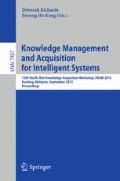Abstract
Emotion detection from text is still an appealing challenge. The approaches to this problem have been done firstly based on just emotional keywords, and then extended with utilizing also other generic terms. However, they still lack of some useful semantic features, such as a psychological characteristic that emotion is the result of a mental state sequence. Recent works focus on using rules to exploit those features, but have the coverage problem. In this paper, we propose a method using the high-order Hidden Markov Model whose states are automatically generated to model the process that a mental state sequence causes an emotion. Our experiments on the ISEAR dataset have shown a better result in comparison with the state-of-the-art methods.
Access this chapter
Tax calculation will be finalised at checkout
Purchases are for personal use only
Preview
Unable to display preview. Download preview PDF.
References
Boucouvalas, A.C.: Real Time Text-to-Emotion Engine for Expressive Internet Communications. In: Riva, G., Davide, F., IJsselsteijn, W.A. (eds.) Emerging Communication: Studies on New Technologies and Practices in Communication, pp. 305–318. IOS Press, Amsterdam (2003)
Chaumartin, F.R.: UPAR7: A Knowledge-based System for Headline Sentiment Tagging. In: Proceedings of the 4th International Workshop on Semantic Evaluations, pp. 422–425 (2007)
Danisman, T., Alpkocak, A.: Feeler: Emotion Classification of Text Using Vector Space Model. In: AISB 2008 Convention, Communication, Interaction and Social Intelligence, vol. 2, pp. 53–59 (2008)
Deerwester, S., Dumais, S.T., Furnas, G.W., Landauer, T.K., Harshman, R.: Indexing by Latent Semantic Analysis. Journal of the American Society for Information Science 41(6), 391–407 (1990)
Ekman, P.: An Argument for Basic Emotions. Cognition & Emotion 6(3), 169–200 (1992)
Ester, M., Kriegel, H.-P., Sander, J., Xu, X.: A Density-Based Algorithm for Discovering Clusters in Large Spatial Databases with Noise. In: Proceedings of 2nd International Conference on Knowledge Discovery and Data Mining, pp. 226–231 (1996)
Esuli, A., Sebastiani, F.: SentiWordNet: A Publicly Available Lexical Resource for Opinion Mining. In: Proceedings of the 5th Conference on Language Resources and Evaluation, pp. 417–422 (2006)
Huang, C.-R., Chen, Y., Lee, S.Y.M.: Textual Emotion Processing from Event Analysis. In: Proceedings of the Joint Conference on Chinese Language Processing (2010)
Kao, E.C.-C., Liu, C.-C., Yang, T.-H., Hsieh, C.-T., Soo, V.-W.: Towards Text-based Emotion Detection: A Survey and Possible Improvements. In: Proceedings of the 2009 International Conference on Information Management and Engineering, pp. 70–74 (2009)
Kim, S.M., Valitutti, A., Calvo, R.A.: Evaluation of Unsupervised Emotion Models to Textual Affect Recognition. In: Proceedings of the NAACL HLT 2010 Workshop on Computational Approaches to Analysis and Generation of Emotion in Text, pp. 62–70 (2010)
Marcus, M.P., Marcinkiewicz, M.A., Santorini, B.: Building a Large Annotated Corpus of English: the Penn Treebank. Comput. Linguist 19(2), 313–330 (1993)
Marneffe, M.-C., Manning, C.D.: Stanford Typed Dependencies Manual (2011)
Picard, R.W.: Affective Computing. MIT Press (1997)
Řehůřek, R., Sojka, P.: Software Framework for Topic Modelling with Large Corpora. In: Proceedings of LREC 2010 Workshop New Challenges for NLP Frameworks, pp. 45–50 (2010)
Russell, J.A.: Core Affect and the Psychological Construction of Emotion. Psychological Review 110(1), 145–172 (2003)
Scherer, K.R., Wallbott, H.G.: Evidence for Universality and Cultural Variation of Differential Emotion Response Patterning. Journal of Personality and Social Psychology 66, 310–328 (1994)
Strapparava, C., Mihalcea, R.: Learning to Identify Emotions in Text. In: Proceedings of the 2008 ACM Symposium on Applied Computing, pp. 1556–1560 (2008)
Strapparava, C., Valitutti, A.: WordNet-Affect: An Affective Extension of WordNet. In: Proceedings of the 4th International Conference on Language Resources and Evaluation, pp. 1083–1086 (2004)
Wu, C.-H., Chuang, Z.-J., Lin, Y.-C.: Emotion Recognition from Text Using Semantic Labels and Separable Mixture Models. ACM Transactions on Asian Language Information Processing 5(2), 165–183 (2006)
Yang, C., Lin, K.H.-Y., Chen, H.-H.: Emotion Classification Using Web Blog Corpora. In: Proceedings of the IEEE/WIC/ACM International Conference on Web Intelligence, pp. 275–278 (2007)
Ye, F., Yi, N., Wang, Y.: EM Algorithm for Training High-order Hidden Markov Model with Multiple Observation Sequences. Journal of Information & Computational Science 8(10), 1761–1777 (2011)
Author information
Authors and Affiliations
Editor information
Editors and Affiliations
Rights and permissions
Copyright information
© 2012 Springer-Verlag Berlin Heidelberg
About this paper
Cite this paper
Ho, D.T., Cao, T.H. (2012). A High-Order Hidden Markov Model for Emotion Detection from Textual Data. In: Richards, D., Kang, B.H. (eds) Knowledge Management and Acquisition for Intelligent Systems. PKAW 2012. Lecture Notes in Computer Science(), vol 7457. Springer, Berlin, Heidelberg. https://doi.org/10.1007/978-3-642-32541-0_8
Download citation
DOI: https://doi.org/10.1007/978-3-642-32541-0_8
Publisher Name: Springer, Berlin, Heidelberg
Print ISBN: 978-3-642-32540-3
Online ISBN: 978-3-642-32541-0
eBook Packages: Computer ScienceComputer Science (R0)

